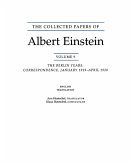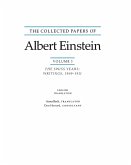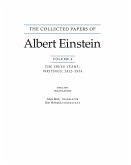Collected Scientific Papers of Sir William Bate Hardy
Herausgeber: Rideal, Etic K.
Collected Scientific Papers of Sir William Bate Hardy
Herausgeber: Rideal, Etic K.
- Broschiertes Buch
- Merkliste
- Auf die Merkliste
- Bewerten Bewerten
- Teilen
- Produkt teilen
- Produkterinnerung
- Produkterinnerung
This book contains 59 scientific papers on a variety of subjects by celebrated British biologist Sir William Bate Hardy (1864-1934).
Andere Kunden interessierten sich auch für
![The Scientific Papers of the Honourable Henry Cavendish, F. R. S The Scientific Papers of the Honourable Henry Cavendish, F. R. S]() Henry CavendishThe Scientific Papers of the Honourable Henry Cavendish, F. R. S62,99 €
Henry CavendishThe Scientific Papers of the Honourable Henry Cavendish, F. R. S62,99 €![Collected Letters of Erasmus Darwin Collected Letters of Erasmus Darwin]() Erasmus DarwinCollected Letters of Erasmus Darwin207,99 €
Erasmus DarwinCollected Letters of Erasmus Darwin207,99 €![The Collected Papers of Albert Einstein, Volume 9. (English) The Collected Papers of Albert Einstein, Volume 9. (English)]() Albert EinsteinThe Collected Papers of Albert Einstein, Volume 9. (English)55,99 €
Albert EinsteinThe Collected Papers of Albert Einstein, Volume 9. (English)55,99 €![The Collected Papers of Albert Einstein, Volume 6 (English) The Collected Papers of Albert Einstein, Volume 6 (English)]() Albert EinsteinThe Collected Papers of Albert Einstein, Volume 6 (English)65,99 €
Albert EinsteinThe Collected Papers of Albert Einstein, Volume 6 (English)65,99 €![The Collected Papers of Albert Einstein, Volume 2 (English) The Collected Papers of Albert Einstein, Volume 2 (English)]() Albert EinsteinThe Collected Papers of Albert Einstein, Volume 2 (English)49,99 €
Albert EinsteinThe Collected Papers of Albert Einstein, Volume 2 (English)49,99 €![The Collected Papers of Albert Einstein, Volume 3 (English) The Collected Papers of Albert Einstein, Volume 3 (English)]() Albert EinsteinThe Collected Papers of Albert Einstein, Volume 3 (English)59,99 €
Albert EinsteinThe Collected Papers of Albert Einstein, Volume 3 (English)59,99 €![The Collected Papers of Albert Einstein, Volume 4 (English) The Collected Papers of Albert Einstein, Volume 4 (English)]() Albert EinsteinThe Collected Papers of Albert Einstein, Volume 4 (English)58,99 €
Albert EinsteinThe Collected Papers of Albert Einstein, Volume 4 (English)58,99 €-
-
-
This book contains 59 scientific papers on a variety of subjects by celebrated British biologist Sir William Bate Hardy (1864-1934).
Produktdetails
- Produktdetails
- Verlag: Cambridge University Press
- Seitenzahl: 970
- Erscheinungstermin: 23. September 2014
- Englisch
- Abmessung: 280mm x 210mm x 51mm
- Gewicht: 2318g
- ISBN-13: 9781107475083
- ISBN-10: 1107475082
- Artikelnr.: 41608677
- Herstellerkennzeichnung
- Libri GmbH
- Europaallee 1
- 36244 Bad Hersfeld
- gpsr@libri.de
- Verlag: Cambridge University Press
- Seitenzahl: 970
- Erscheinungstermin: 23. September 2014
- Englisch
- Abmessung: 280mm x 210mm x 51mm
- Gewicht: 2318g
- ISBN-13: 9781107475083
- ISBN-10: 1107475082
- Artikelnr.: 41608677
- Herstellerkennzeichnung
- Libri GmbH
- Europaallee 1
- 36244 Bad Hersfeld
- gpsr@libri.de
1. On some points in the histology and development of myriothela phrygia
2. On the reaction of certain cell-granules with methylene blue
3. The blood corpuscles of the crustacea, together with a suggestion as to the origin of the crustacean fibrin-ferment
4. The protective functions of the skin of certain animals
5. On the structure and functions of the alimentary canal of daphnia
6. On the characters and behaviour of the wandering (migrating) cells of the frog, especially in relation to micro-organisms
7. On the changes in the number and character of the wandering cells of the frog induced by the presence of urari or of bacillus anthracis
8. The morphology and distribution of the wandering cells of mammalia
9. On some histological features and physiological properties of the post-oesophageal nerve cord of the crustacea
10. On the characters and behaviour of the wandering (migrating) cells of the frog, especially in relation to micro-organisms
11. Note on the oxidising powers of different regions of the spectrum in relation to the bactericidal action of light and air
12. The wandering cells of the alimentary canal
13. Further observations upon the action of the oxyphil and hyaline cells of frog's lymph upon bacilli
14. On the structure of cell protoplasm
15. On the coagulation of proteid by electricity
16. A preliminary investigation of the conditions which determine the stability of irreversible hydrosols
17. On the mechanism of gelation in reversible colloidal systems
18. The action of salts of radium upon globulins
19. On the sensation of light produced by radium rays and its relation to visual purple
20. On the oxidising action of the rays from radium bromide as shown by the decomposition of iodoform
21. Colloidal solution. The globulins
22. Colloidal solution. The globulin system
23. On globulins. Croonian lecture
24. The physical basis of life
25. Electrolytes and colloids - the physical state of gluten
26. Electrolytic colloids
27. Proteins of blood plasma
28. Note on the surface electric charges of living cells
29. The general theory of colloidal solutions
30. The tension of composite fluid surfaces and the mechanical stability of films of fluid
31. On the formation of a heat-reversible gel
32. The influence of chemical constitution upon interfacial tension
33. The tension of composite fluid surfaces. II
34. Note on differences in electrical potential within the living cell
35. An application of the principle of dynamical similitude to molecular physics
36. Some problems of living matter. The Guthrie lecture
37. Note on static friction and on the lubricating properties of certain chemical substances
38. The spreading of fluids on glass
39. Static friction. II
40. Problems of lubrication
41. Boundary lubrication. The paraffin series
42. Boundary lubrication. The temperature coefficient
43. Boundary lubrication. The latent period and mixtures of two lubricants
44. Boundary lubrication. Plane surfaces and the limitations of Amontons' law
45. On the spreading of fluids on water and solids: and the thickness of a primary film
46. Chemistry at interfaces
47. Films
48. Living matter
49. A microscopic study of the freezing of gel
50. Studies in adhesion. I
51. Studies in adhesion. II
52. Molecular orientation in living matter
53. Freie und gebudene Flüssigkeit in Gelen
54. Statische Reibung und Adsoption
55. Note on the central nervous system of the crayfish
56. Problems of the boundary state
57. Adsorption. A study of availability and accessibility
58. The freezing point of yolk and white of egg
59. To remind: a biological essay. The Abraham Flexner lecture
Index.
2. On the reaction of certain cell-granules with methylene blue
3. The blood corpuscles of the crustacea, together with a suggestion as to the origin of the crustacean fibrin-ferment
4. The protective functions of the skin of certain animals
5. On the structure and functions of the alimentary canal of daphnia
6. On the characters and behaviour of the wandering (migrating) cells of the frog, especially in relation to micro-organisms
7. On the changes in the number and character of the wandering cells of the frog induced by the presence of urari or of bacillus anthracis
8. The morphology and distribution of the wandering cells of mammalia
9. On some histological features and physiological properties of the post-oesophageal nerve cord of the crustacea
10. On the characters and behaviour of the wandering (migrating) cells of the frog, especially in relation to micro-organisms
11. Note on the oxidising powers of different regions of the spectrum in relation to the bactericidal action of light and air
12. The wandering cells of the alimentary canal
13. Further observations upon the action of the oxyphil and hyaline cells of frog's lymph upon bacilli
14. On the structure of cell protoplasm
15. On the coagulation of proteid by electricity
16. A preliminary investigation of the conditions which determine the stability of irreversible hydrosols
17. On the mechanism of gelation in reversible colloidal systems
18. The action of salts of radium upon globulins
19. On the sensation of light produced by radium rays and its relation to visual purple
20. On the oxidising action of the rays from radium bromide as shown by the decomposition of iodoform
21. Colloidal solution. The globulins
22. Colloidal solution. The globulin system
23. On globulins. Croonian lecture
24. The physical basis of life
25. Electrolytes and colloids - the physical state of gluten
26. Electrolytic colloids
27. Proteins of blood plasma
28. Note on the surface electric charges of living cells
29. The general theory of colloidal solutions
30. The tension of composite fluid surfaces and the mechanical stability of films of fluid
31. On the formation of a heat-reversible gel
32. The influence of chemical constitution upon interfacial tension
33. The tension of composite fluid surfaces. II
34. Note on differences in electrical potential within the living cell
35. An application of the principle of dynamical similitude to molecular physics
36. Some problems of living matter. The Guthrie lecture
37. Note on static friction and on the lubricating properties of certain chemical substances
38. The spreading of fluids on glass
39. Static friction. II
40. Problems of lubrication
41. Boundary lubrication. The paraffin series
42. Boundary lubrication. The temperature coefficient
43. Boundary lubrication. The latent period and mixtures of two lubricants
44. Boundary lubrication. Plane surfaces and the limitations of Amontons' law
45. On the spreading of fluids on water and solids: and the thickness of a primary film
46. Chemistry at interfaces
47. Films
48. Living matter
49. A microscopic study of the freezing of gel
50. Studies in adhesion. I
51. Studies in adhesion. II
52. Molecular orientation in living matter
53. Freie und gebudene Flüssigkeit in Gelen
54. Statische Reibung und Adsoption
55. Note on the central nervous system of the crayfish
56. Problems of the boundary state
57. Adsorption. A study of availability and accessibility
58. The freezing point of yolk and white of egg
59. To remind: a biological essay. The Abraham Flexner lecture
Index.
1. On some points in the histology and development of myriothela phrygia
2. On the reaction of certain cell-granules with methylene blue
3. The blood corpuscles of the crustacea, together with a suggestion as to the origin of the crustacean fibrin-ferment
4. The protective functions of the skin of certain animals
5. On the structure and functions of the alimentary canal of daphnia
6. On the characters and behaviour of the wandering (migrating) cells of the frog, especially in relation to micro-organisms
7. On the changes in the number and character of the wandering cells of the frog induced by the presence of urari or of bacillus anthracis
8. The morphology and distribution of the wandering cells of mammalia
9. On some histological features and physiological properties of the post-oesophageal nerve cord of the crustacea
10. On the characters and behaviour of the wandering (migrating) cells of the frog, especially in relation to micro-organisms
11. Note on the oxidising powers of different regions of the spectrum in relation to the bactericidal action of light and air
12. The wandering cells of the alimentary canal
13. Further observations upon the action of the oxyphil and hyaline cells of frog's lymph upon bacilli
14. On the structure of cell protoplasm
15. On the coagulation of proteid by electricity
16. A preliminary investigation of the conditions which determine the stability of irreversible hydrosols
17. On the mechanism of gelation in reversible colloidal systems
18. The action of salts of radium upon globulins
19. On the sensation of light produced by radium rays and its relation to visual purple
20. On the oxidising action of the rays from radium bromide as shown by the decomposition of iodoform
21. Colloidal solution. The globulins
22. Colloidal solution. The globulin system
23. On globulins. Croonian lecture
24. The physical basis of life
25. Electrolytes and colloids - the physical state of gluten
26. Electrolytic colloids
27. Proteins of blood plasma
28. Note on the surface electric charges of living cells
29. The general theory of colloidal solutions
30. The tension of composite fluid surfaces and the mechanical stability of films of fluid
31. On the formation of a heat-reversible gel
32. The influence of chemical constitution upon interfacial tension
33. The tension of composite fluid surfaces. II
34. Note on differences in electrical potential within the living cell
35. An application of the principle of dynamical similitude to molecular physics
36. Some problems of living matter. The Guthrie lecture
37. Note on static friction and on the lubricating properties of certain chemical substances
38. The spreading of fluids on glass
39. Static friction. II
40. Problems of lubrication
41. Boundary lubrication. The paraffin series
42. Boundary lubrication. The temperature coefficient
43. Boundary lubrication. The latent period and mixtures of two lubricants
44. Boundary lubrication. Plane surfaces and the limitations of Amontons' law
45. On the spreading of fluids on water and solids: and the thickness of a primary film
46. Chemistry at interfaces
47. Films
48. Living matter
49. A microscopic study of the freezing of gel
50. Studies in adhesion. I
51. Studies in adhesion. II
52. Molecular orientation in living matter
53. Freie und gebudene Flüssigkeit in Gelen
54. Statische Reibung und Adsoption
55. Note on the central nervous system of the crayfish
56. Problems of the boundary state
57. Adsorption. A study of availability and accessibility
58. The freezing point of yolk and white of egg
59. To remind: a biological essay. The Abraham Flexner lecture
Index.
2. On the reaction of certain cell-granules with methylene blue
3. The blood corpuscles of the crustacea, together with a suggestion as to the origin of the crustacean fibrin-ferment
4. The protective functions of the skin of certain animals
5. On the structure and functions of the alimentary canal of daphnia
6. On the characters and behaviour of the wandering (migrating) cells of the frog, especially in relation to micro-organisms
7. On the changes in the number and character of the wandering cells of the frog induced by the presence of urari or of bacillus anthracis
8. The morphology and distribution of the wandering cells of mammalia
9. On some histological features and physiological properties of the post-oesophageal nerve cord of the crustacea
10. On the characters and behaviour of the wandering (migrating) cells of the frog, especially in relation to micro-organisms
11. Note on the oxidising powers of different regions of the spectrum in relation to the bactericidal action of light and air
12. The wandering cells of the alimentary canal
13. Further observations upon the action of the oxyphil and hyaline cells of frog's lymph upon bacilli
14. On the structure of cell protoplasm
15. On the coagulation of proteid by electricity
16. A preliminary investigation of the conditions which determine the stability of irreversible hydrosols
17. On the mechanism of gelation in reversible colloidal systems
18. The action of salts of radium upon globulins
19. On the sensation of light produced by radium rays and its relation to visual purple
20. On the oxidising action of the rays from radium bromide as shown by the decomposition of iodoform
21. Colloidal solution. The globulins
22. Colloidal solution. The globulin system
23. On globulins. Croonian lecture
24. The physical basis of life
25. Electrolytes and colloids - the physical state of gluten
26. Electrolytic colloids
27. Proteins of blood plasma
28. Note on the surface electric charges of living cells
29. The general theory of colloidal solutions
30. The tension of composite fluid surfaces and the mechanical stability of films of fluid
31. On the formation of a heat-reversible gel
32. The influence of chemical constitution upon interfacial tension
33. The tension of composite fluid surfaces. II
34. Note on differences in electrical potential within the living cell
35. An application of the principle of dynamical similitude to molecular physics
36. Some problems of living matter. The Guthrie lecture
37. Note on static friction and on the lubricating properties of certain chemical substances
38. The spreading of fluids on glass
39. Static friction. II
40. Problems of lubrication
41. Boundary lubrication. The paraffin series
42. Boundary lubrication. The temperature coefficient
43. Boundary lubrication. The latent period and mixtures of two lubricants
44. Boundary lubrication. Plane surfaces and the limitations of Amontons' law
45. On the spreading of fluids on water and solids: and the thickness of a primary film
46. Chemistry at interfaces
47. Films
48. Living matter
49. A microscopic study of the freezing of gel
50. Studies in adhesion. I
51. Studies in adhesion. II
52. Molecular orientation in living matter
53. Freie und gebudene Flüssigkeit in Gelen
54. Statische Reibung und Adsoption
55. Note on the central nervous system of the crayfish
56. Problems of the boundary state
57. Adsorption. A study of availability and accessibility
58. The freezing point of yolk and white of egg
59. To remind: a biological essay. The Abraham Flexner lecture
Index.









